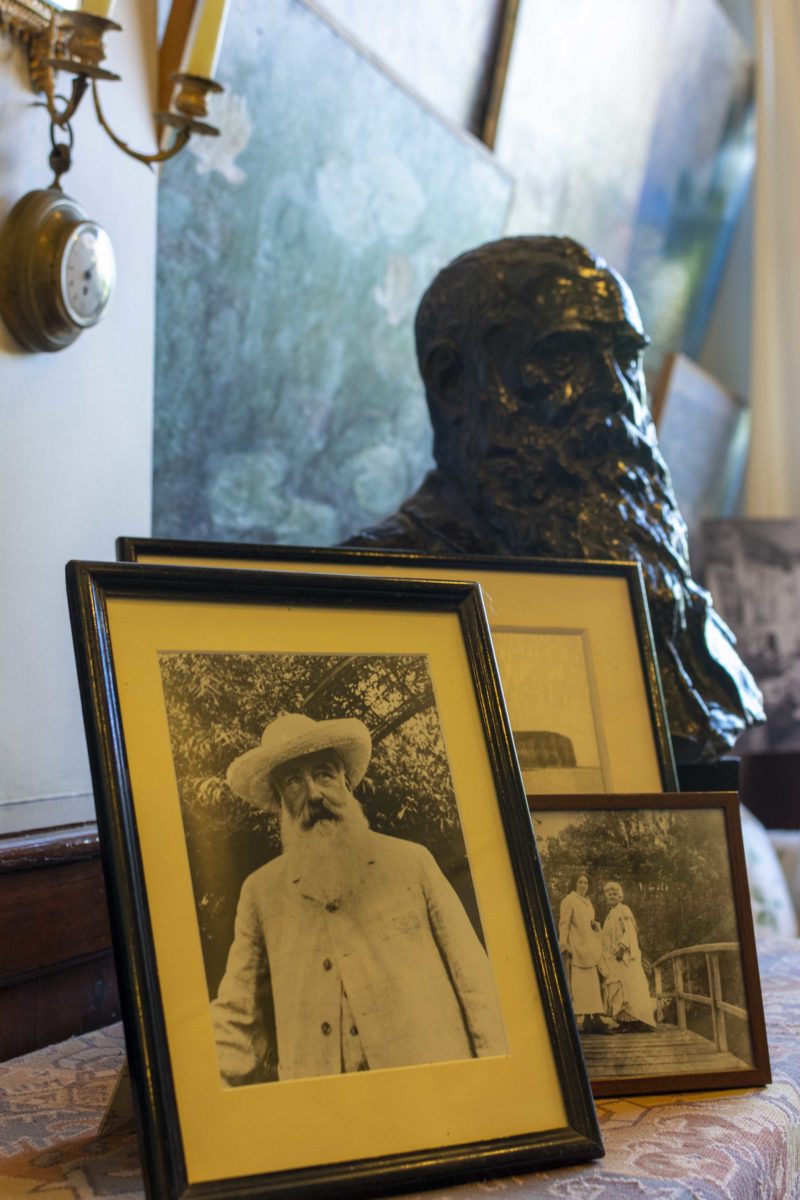While my Chéri was on holiday at home, we went to visit the house of the famous Impressionist artist Claude Monet in the nearby village of Giverny. We live a short one hour drive from the village and it was my third visit, but surprisingly my husband had never been there.
These days you have to book your tickets and a time slot on the website. I bought tickets for 9.30am hoping that with the lack of foreign tourists in France this summer, there would be a few people. We arrived a little late, as we always tend to do, and had to queue to walk around the infamous lily pond where there was already quite a crowd, although nothing like the usual crowd of coach parties.
Having visited before, I was mainly hoping to get inspiration for our new garden as we will be moving to a new house next spring. But it is also an immense pleasure to share such places and visits with my husband, who finally realized in his late 50s and after a serious burnout that an “all work and no play” lifestyle is very bad for your health and relationships.

This week I will share with you photographs that I took inside Monet’s home in Giverny. While I was preparing this article, I realized that although, living near Paris, I have had the great pleasure of seeing many of the artist’s paintings in real life, I actually know very little about his life.
Maybe you don’t either, so, I’ve done a little research.
Claude Monet, A Short Biographie – Childhood And Early Career.
Claude Monet was born on 14 November 1840, in the 9th arrondissement of Paris. He was the second son of Claude Adolphe Monet and Louise Justine Aubrée Monet, both of them second-generation Parisians. In 1845, his family moved to Le Havre in Normandy. His father wanted him to go into the family’s ship-chandling, dealing in supplies for ships, and grocery business, but Monet wanted to become an artist. His mother was a singer, and supported Monet’s desire for a career in art.
On 1 April 1851, Monet entered Le Havre secondary school of the arts. On the beaches of Normandy around 1856 he met fellow artist Eugène Boudin, who became his mentor and taught him to use oil paints. Boudin taught Monet “en plein air” (outdoor) techniques for painting. Monet was then in Paris for several years and met other young painters, including Édouard Manet and others who would become friends and fellow Impressionists.
After drawing a low ballot number in March 1861, Monet was drafted into the First Regiment of African Light Cavalry in Algeria, for a seven-year period of military service. After about a year of garrison duty in Algiers, Monet contracted typhoid fever. Following convalescence, Monet’s aunt intervened to remove him from the army if he agreed to complete a course at an art school.
Disillusioned with the traditional art taught at art schools, in 1862 Monet became a student of Charles Gleyre in Paris, where he met Pierre-Auguste Renoir, Frédéric Bazille and Alfred Sisley. Together they shared new approaches to art, painting the effects of light en plein air with broken colour and rapid brushstrokes.
During the latter part of 1873, Monet, Pierre-Auguste Renoir, Camille Pissarro, and Alfred Sisley organized the Société anonyme des artistes peintres, sculpteurs et graveurs (Anonymous Society of Painters, Sculptors, and Engravers) to exhibit their artworks independently. At their first exhibition, held in April 1874, Monet exhibited the work that was to give the group its lasting name, Impression, Sunrise was painted in 1872, depicting a Le Havre port landscape.
And the rest of his career is, as we say, History.
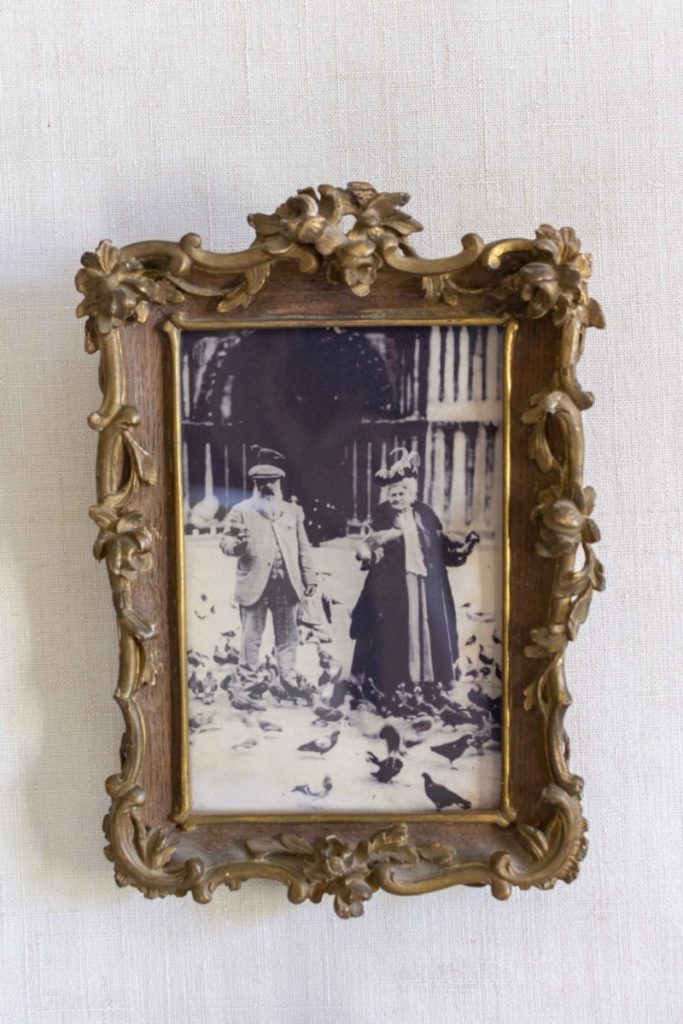
Love, Poverty And Marriage.
Camille Doncieux met Monet, seven years her senior, in 1865 and became his model, posing for numerous paintings. She was Monet’s mistress, living in poverty at the beginning of his career. His aunt and father did not approve of the relationship with Camille. During Camille’s pregnancy with their first son, Monet left her in Paris and stayed at his aunt’s country estate to protect the monthly cheque that he received from the family, and give the appearance that he was no longer in a relationship with Camille. She was left behind in Paris without funds for her care.
In Paris on 8 August 1867, Camille gave birth to Jean, her first son with Claude Monet. In 1868 Monet went to live with Camille and Jean in Paris, hiding the fact from his father and aunt who thought he had abandoned “his mistress and child”. To escape his creditors and live in a less expensive place, in the spring the three moved to Gloton, a small scenic village near Bennecourt. They were thrown out of the inn they were staying in for non-payment. Camille and Jean were able to stay with someone in the country, while Monet tried to obtain monies for survival.
Camille and Monet were married on 28 June 1870 in Paris during a civil ceremony.
In 1876, Camille became ill with tuberculosis. Their second son, Michel, was born on 17 March 1878. In the summer of that year, the family moved to the village of Vétheuil where they shared a house with the family of Ernest Hoschedé, a wealthy department store owner and patron of the arts. In 1878, Camille Monet was diagnosed with uterine cancer and died on 5 September 1879 at the age of thirty-two.
Monet’s friend Ernest Hoschedé became bankrupt, and left in 1878 for Belgium. After the death of Camille Monet in September 1879, and while Monet continued to live in the house in Vétheuil, Alice Hoschedé helped Monet to raise his two sons, Jean and Michel. She took them to Paris to live alongside her own six children. In 1883, looking out the window of the little train between Vernon and Gasny, he discovered Giverny in Normandy. Monet, Alice Hoschedé and the children moved to Vernon, then to the house in Giverny, where he planted his now famous garden and where he painted for much of the rest of his life.
The Monet Familly Home From 1883 to 1926.
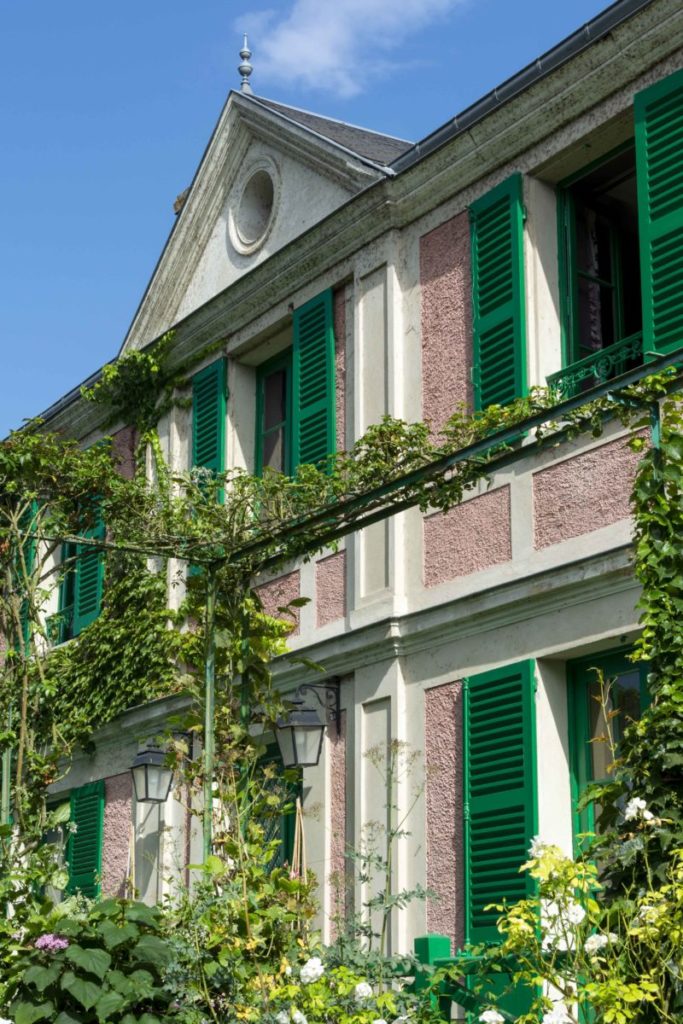
Originally, this beautiful house belonged to Louis-Joseph Singeot, farmer and wine grower. In April 1883, the house was rented to Claude Monet, who moved in with Alice Hoschedé and her children.
On entering the house, you can imagine a home filled with the busyness of eight children, Claude Monet’s comings and goings between his studio and the garden, the atmosphere of the kitchen in the early morning when vegetables came fresh from the kitchen-garden, plus the returns from market and arrival of friends from Paris.
The yellow dinning room ….
The dining room has been restored with precision. You can see the collection of Japanese « estampes » on the yellow walls, a style of art that was new and exotic at the time and greatly inspired the Impressionists. The furniture , also painted yellow, was considered very modern at the time. In the glass cabinets the blue earthenware crockery and the yellow and blue sets that Monet ordered for special occasions, are displayed.
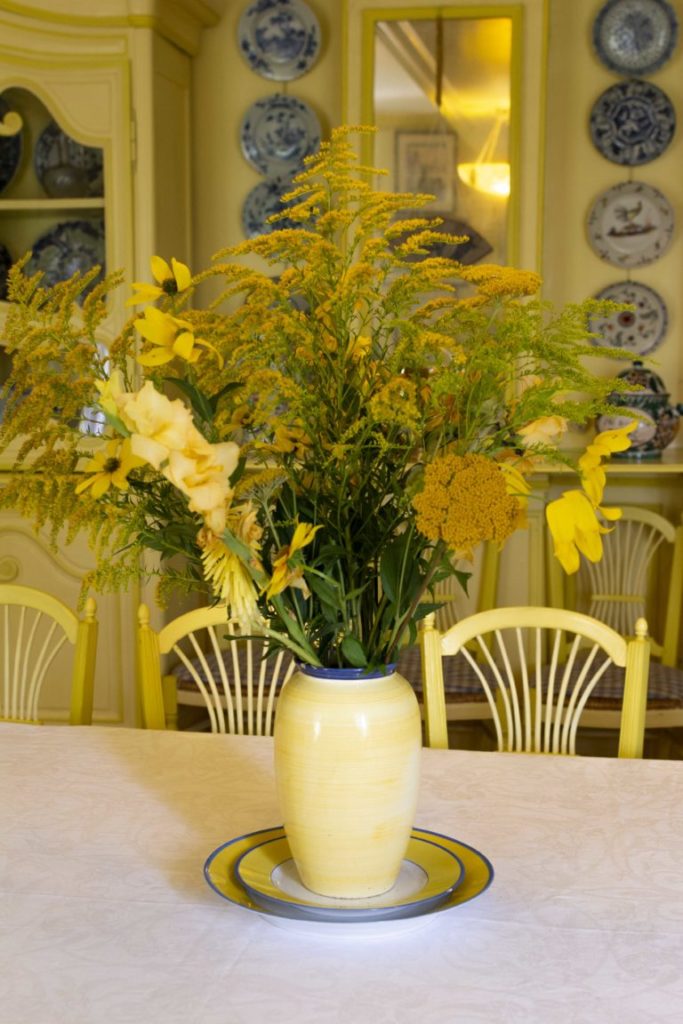
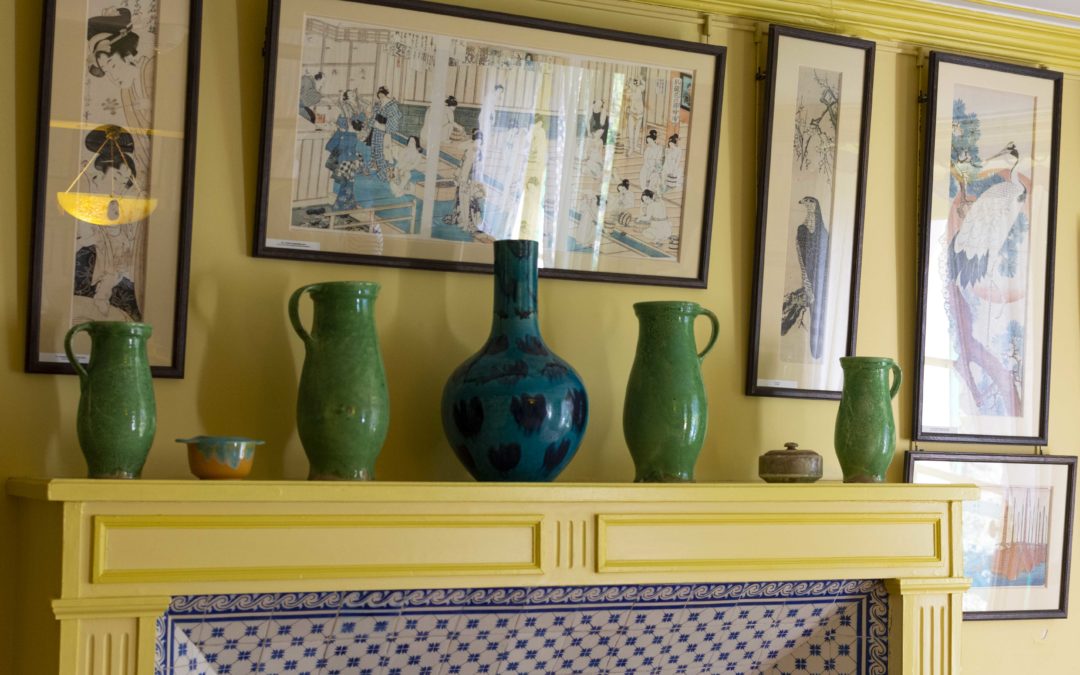
Details of the blue kitchen …..
In the kitchen, with its blue Rouen tiles, the impressive cooker with multiple ovens and the copper utensils seem to be waiting for the return of their owners.

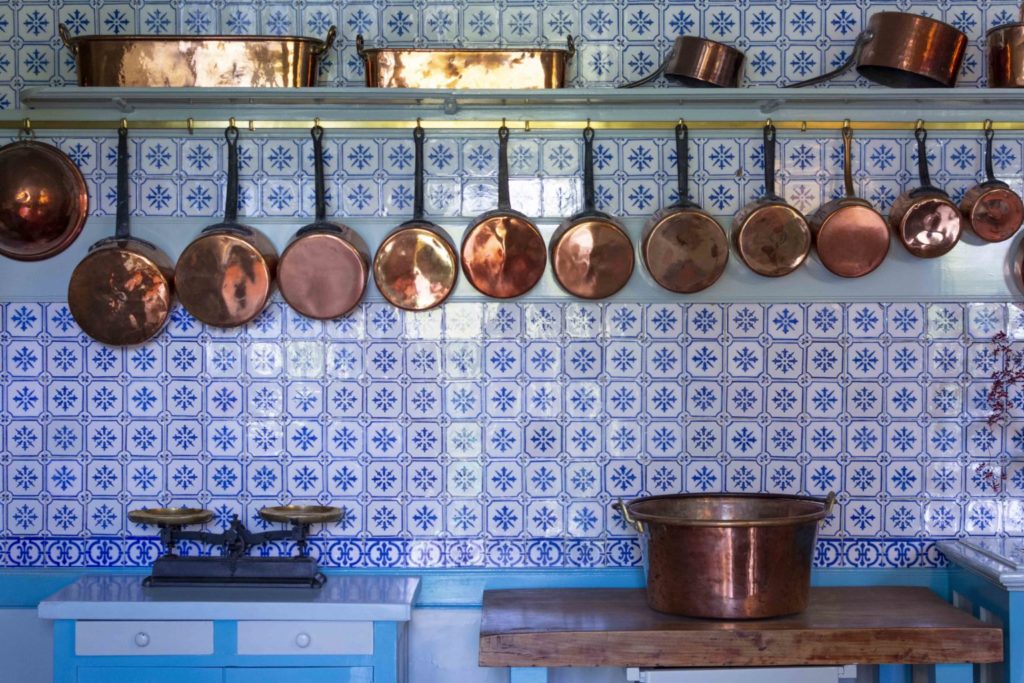
A narrow staircase leads to the first floor and Monet’s bedroom, which underwent a meticulous scenographic reconstitutionin 2013. Objects and artwork from Monet’s day are displayed in the bedroom and in the adjoining bathroom, including reproductions of paintings by his friends: Cézanne, Renoir, Signac or Caillebotte.
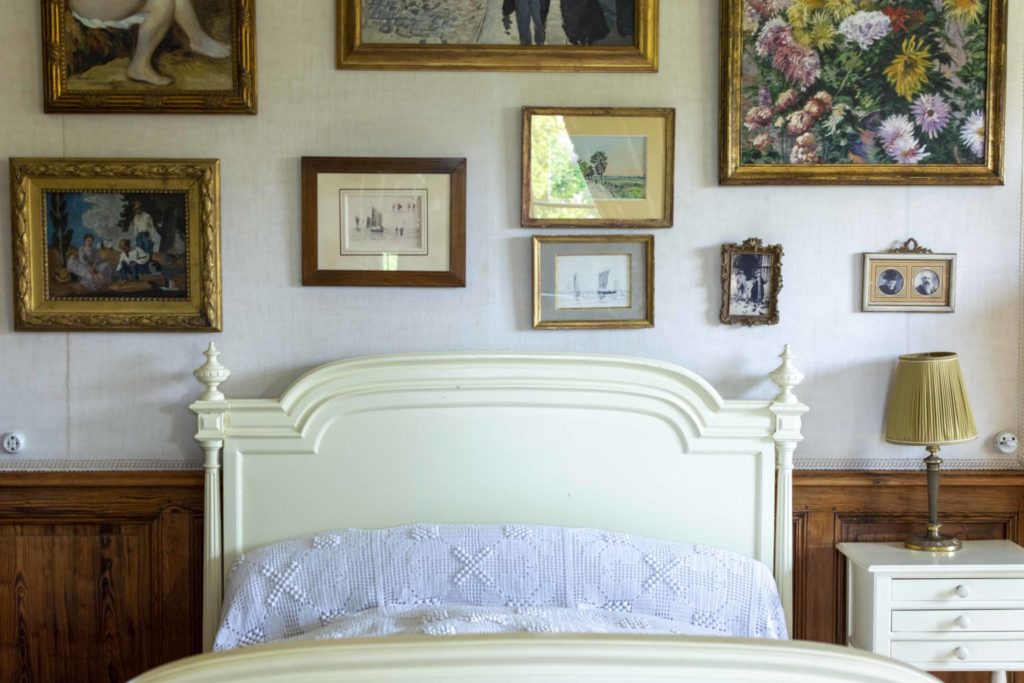
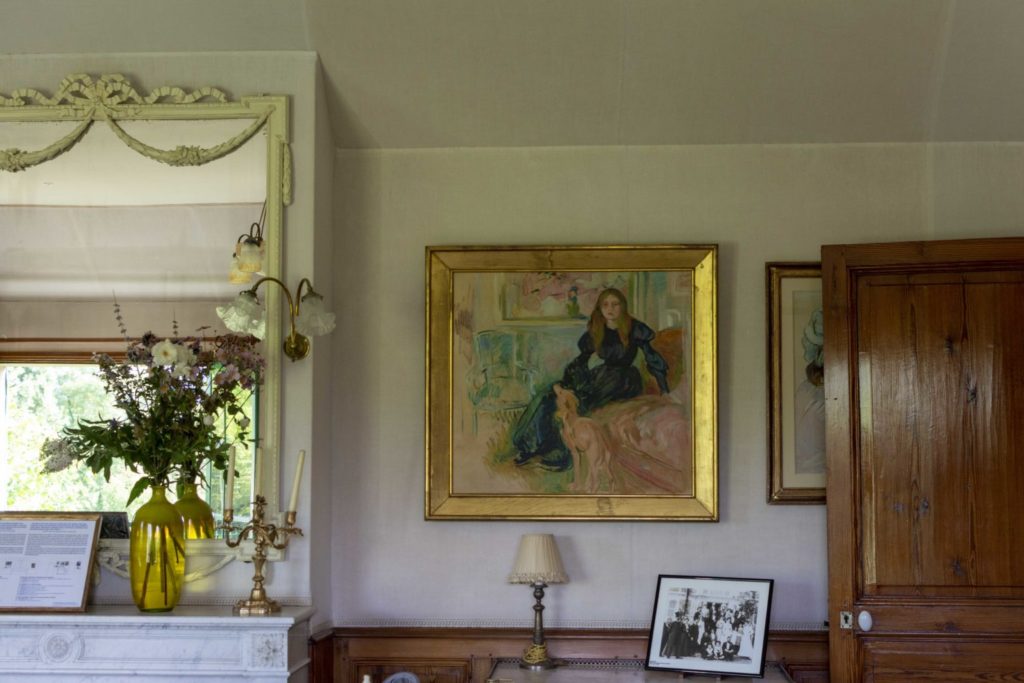
The visit continues through their dressing rooms and on to Alice’s bedroom, leading to a tiny sewing room. Finally, the last room on that floor, Blanche Hoschedé-Monet’s bedroom (Alice’s daughter), which was opened to the public for the first time in 2014.
As in Monet’s bedroom, Hubert Le Gall was responsible for the scenographic reconstitution, inspired by interiors from that period in order to recreate as close as possible the surroundings of Blanche who lived in Giverny until her death in 1947.


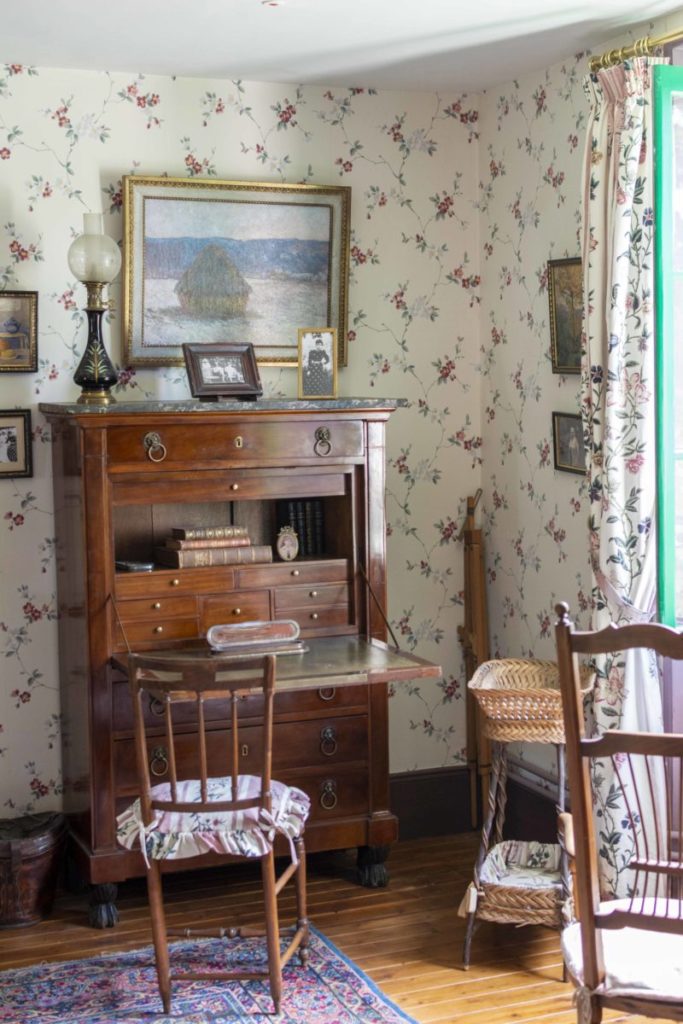
It was a surprise to see so many illustrious paintings in this ordinary setting, but we suppose that they are copies for security’s sake. As you can see the combination of colours in the decor is calm and gentle in some rooms, and then stunning and avant garde in others. It is easy to imagine Monet living out his more successful years in this cosy home, bursting with family, which is probably why he also needed the quiet of his beautiful garden.
The house and gardens are managed by the Fondation Claude Monet Giverny. The Director of the Foundation Hugues R. Gall is quoted on the web site:
« The restoration works conducted by Gérald and Florence Van der Kemp, thanks notably to American Maecenas, have allowed Claude Monet’s house and gardens to become again a unique place, with a deep quietude and a perpetual enchantment.
Every year, more than 500,000 visitors come from all over the world in order to feel this so particular atmosphere. The “Fondation Claude Monet”, owned by the “Académie des Beaux Arts”, must remain a living place. Our gardeners work all along the year to highlight the gardens, to “reconstruct” them permanently, to preserve and renew the vegetal patrimony, while always being faithful to the Great Painter’s vision. »
The Foundation also has a Vimeo account, where you can watch various videos like this one:
There is a wealth of good things to see and read on the foundations website here, in French, English or Japanese.
In my next post, I’ll show you some of the photos that I took in the garden, including some blurry ones 🙂 .
* * * * * * * * * *
Can you help me widen my circle of readers?
If you know people who you think would enjoy my site, please share this post on your social media or by email.
It’s easy, just copy and paste this link:
https://henriericher.com/blog/
* * * * * * *
Thank you for visiting.
Take Care,
Henrie
XOX
